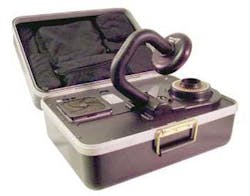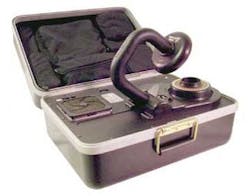New System Detects Biological Agents in Water
DNA technology can be used to quickly and accurately identify biological agents in a wide variety of matrices, including water. The Idaho Technology Inc. (ITI) Ruggedized Advanced Pathogen Identification Device (R.A.P.I.D.®) System can detect anthrax, Brucella, plague, E coli, Salmonella, cryptosporidium and others in less than 30 minutes.
This system consists of a heated air thermocycler, fluorimeter, laptop computer and freeze dried reagents. The R.A.P.I.D. offers users a flexible, multi-use platform to test samples including air, water, food, and soil. The company also offers RAZOR, a hand-portable device designed specifically for onsite detection. This technology can be applied to a variety of environmental testing applications.
Over the past three years, Idaho Technology has been committed to developing a complete biothreat detection system for the Department of Defense (DoD). To date, biothreat response teams have used over 400 R.A.P.I.D. instruments and have run over 1.5 million reactions. They have found the system reliable, sensitive, and specific under real-world conditions. Achieving this capability has required advances in instrumentation, reagents, and software.
The R.A.P.I.D. System began with the ruggedization of the LightCycler®, a laboratory instrument, invented at ITI, that is capable of one-step detection of viruses and bacteria based on their nucleic acid signatures. The R.A.P.I.D. contains the same highly sensitive fluorimeter as its LightCycler parent and the same fast and accurate temperature control.
To accommodate minimally trained users, the company replaced the LightCycler's complicated instrument programming screen with a simple button screen. Pressing the button labeled "Anthrax," for example, automatically programs the instrument for the Anthrax assay, shows the user the proper pattern for loading capillaries into the instrument, and starts the instrument.
IDI enhanced the data analysis program by adding the "Detector." This pattern-recognition software automatically determines whether a reaction is positive or negative by using a score that is the weighted sum of a set of complex functions. Each function recognizes a distinguishing trait of positive or negative PCR reactions. For example, one function looks at the signal-to-noise ratio of the reaction curve, another asks whether the fluorescence goes above a given threshold value.
Real-Time DNA Amplification
Real-time PCR gives one the ability to quickly and accurately detect biological agents. Today, by combining a hot-air thermocycler, fluorimeter, and fluorescent dyes, users can detect and identify biological agents in less than 30 minutes with the highest specificity and sensitivity. For example, the ITI R.A.P.I.D. System can complete a run in less than half the time of conventional thermocyclers and can also display positive and negative results during the course of the run.
The "real-time" component of DNA amplification comes from fluorescent DNA probes such as dual-labeled hybridization probes. These probes detect specific product after the primers amplify the gene target (e.g. a gene on anthrax). Hybridization probes consist of two short oligonucleotides that bind to the internal sequence of the amplified product during the annealing phase. One probe is labeled at the 3' end with fluorescein and the second probe is labeled at the 5'-end with LightCycler (LC)-Red 640 or LC-Red 705.
A phenomenon called fluorescence resonance energy transfer (FRET) results when both probes bind to the target DNA and come in close proximity. In the R.A.P.I.D. System, a blue LED excites the fluorescein probe to transfer light energy to the LC-Red 640 probe. The fluorescence emitted by the LC-Red 640 probe dye is measured by the instrument's fluorimeter and this data is displayed on the laptop. During a run, the fluorescent signal from each sample can be monitored and compared to background signals to determine crossing threshold (CT).
Assay Validation
External Department of Defense Laboratories validated ITI's real-time assay for the Bacillus anthracis Protective Antigen (PA) at the Armed Forces Institute of Pathology (AFIP). The lab's process included testing for accuracy, precision, sensitivity and specificity.
Two technicians determined accuracy by testing various concentrations of DNA on the R.A.P.I.D. System. DNA was tested at: 1 ng, 100 pg, 10 pg, 1 pg, 100 fg, and 10 fg concentrations. The CT (cycle threshold), or the earliest point where a positive result occurs was observed and compared.
Handheld Device
The RAZOR device moves real-time detection of biological agents to a more compact, lightweight, simpler platform. In this device, temperature cycling is quickly achieved when air bladders move the liquid sample between two heated plates preset to 95°C and 60°C. In other systems, the plastic tube containing the liquid sample must be heated then cooled, which requires more time and energy. RAZOR can achieve 50 cycles under 30 minutes compared to R.A.P.I.D.'s 45 cycles under 30 minutes. RAZOR can run up to 12 samples per run.
Conclusions
Real-time DNA identification systems offer users a flexible platform for identifying biological agents. Applications include water, agricultural, industrial hygiene, environmental sampling, inspection/verification, and transportation uses. Some detection systems can be integrated with front-end collectors, such as air samplers and also wired on-line to create surveillance systems. The technology is moving toward more automated and stand-alone detection systems.

